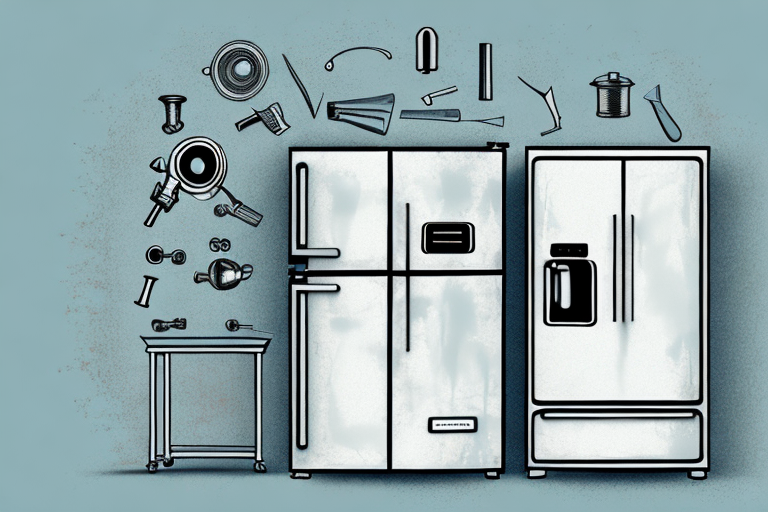Refrigerators are an important appliance in the kitchen, used for storage of both food and drinks. As with many mechanical items, KitchenAid refrigerators can occasionally encounter problems. In the following article, we will discuss the most common problems with KitchenAid refrigerators and how to go about resolving them.
Understanding the Different Types of KitchenAid Refrigerator Problems
Before attempting to fix a KitchenAid refrigerator, it is important to understand the different types of problems that can be encountered. In general, common refrigerator problems fall into one of six categories: ice maker issues, noisy compressor, electrical problems, leaks, temperature control issues, and drainage issues. It is therefore a good idea to identify the type of issue at hand before beginning a repair.
When troubleshooting a KitchenAid refrigerator, it is important to take into account the age of the appliance. Older models may require more extensive repairs, while newer models may be easier to fix. Additionally, it is important to have the correct tools and replacement parts on hand before beginning any repair. This will help to ensure that the repair is done correctly and efficiently.
Troubleshooting Ice Maker Issues
Ice maker issues are one of the most common KitchenAid refrigerator problems. If the ice maker is producing no ice or smaller-than-normal amounts of ice, the issue may be solved by cleaning the ice maker assembly. This involves unplugging the power cord, accessing the ice maker assembly by removing the screws, and scrubbing the mechanism with a damp rag. If this proves ineffective, a replacement ice maker assembly may need to be purchased.
Before attempting to clean the ice maker assembly, it is important to check the water supply line for any blockages or kinks. If the water supply line is blocked, it will prevent the ice maker from receiving the necessary water to produce ice. Additionally, it is important to check the water filter to ensure it is not clogged or expired. If the water filter is clogged or expired, it will also prevent the ice maker from receiving the necessary water to produce ice.
Dealing with Noisy Refrigerator Compressors
Noisy compressors are another potential problem with KitchenAid refrigerators. One of the main causes of this issue is failure to close the freezer doors properly. However, if the doors close properly and the noise persists, the compressor itself may have become defective, resulting in a need for repair or replacement. It is therefore recommended to contact KitchenAid for further assistance.
If the noise is coming from the compressor, it is important to check the condenser coils for any blockages or debris. If the coils are blocked, it can cause the compressor to overheat and make a loud noise. Additionally, it is important to check the fan blades for any damage or debris that may be causing the noise. If the fan blades are damaged, they should be replaced to ensure the compressor is running properly.
Diagnosing Electrical Problems with Your Fridge
Electrical problems with KitchenAid refrigerators can also occur from time to time. Two typical issues include the refrigerator not turning on or displaying error codes. To resolve such issues, users may need to check the power outlet and fuses to ensure that electricity is reaching the fridge, and then reset the refrigerator components and check for possible loose wiring connections.
Addressing Leaks and Water Damage
KitchenAid refrigerators may also be vulnerable to leaks and water damage. Common causes of this problem include a clogged or blocked drain tube or a loose water line connection. In such cases, it is necessary to diagnose and repair the source of the leak before any further damage occurs. Additionally, it is important to periodically clean the interior of the refrigerator in order to prevent mold.
Identifying and Fixing Temperature Control Issues
A malfunctioning temperature control system can also lead to problems with KitchenAid refrigerators. To troubleshoot such issues, users should start by checking the temperature control settings and ensuring that all air vents are open for proper air circulation. If this does not resolve the issue, it is recommended to contact KitchenAid for advice or professional repairs.
Resolving Drainage Issues
Drainage issues can be identified by a buildup of water on the floor near the KitchenAid refrigerator. In such cases, accessing and cleaning the drain tube should resolve this issue. The interior of the fridge should also be thoroughly cleaned to remove any mold or mildew buildup.
Repairing Door Seals and Gaskets
Door seals and gaskets are essential components that keep air inside of a refrigerator. Over time these seals can become worn out, leading to problems with insufficient cooling and resulting in increased energy consumption. To rectify this issue, sealant should be applied evenly around the door seals and gaskets in order to ensure their effectiveness.
How to Avoid Common KitchenAid Refrigerator Problems
Preventative maintenance can help users to avoid many common KitchenAid refrigerator problems. Such maintenance includes cleaning filters, condenser coils and drains regularly; checking door seals for wear and tear; replacing cooling fans and regulating temperature settings in order to avoid overworking the fridge. By taking preventative measures and performing routine inspections, users can address small problems before they become large ones.













